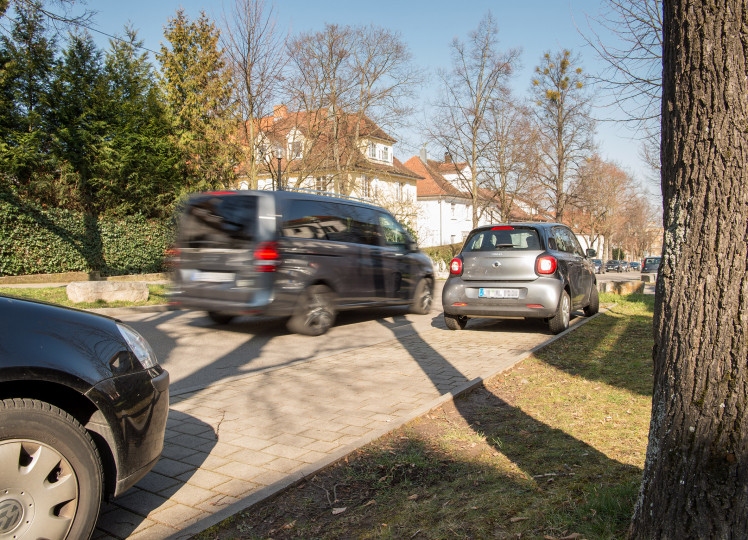Stuttgart – Typically, any trip in a car ends up at a parking space. Of course, the driver has to find one first. In downtown areas, the search for parking spaces is responsible for roughly one-third of traffic, and curbside spaces are especially rare. No wonder that according to the online portal Statista, 87 percent of drivers are interested in solutions that make it easier to find parking. “Searching for an empty parking space is inconvenient, and usually time-consuming and stressful,” says Dr. Dirk Hoheisel, member of the board of management of Robert Bosch GmbH. Bosch has found a way to take the stress out of this process with its community-based parking, an open service platform. What makes this solution so special is that the car itself identifies and reports available available curbside parking spaces that it finds itself. This information is entered into a digital parking map and is provided to all vehicles participating in the service, for example via the navigation system. Drivers can then navigate straight to an available parking space. The service considerably shortens the search for a parking space and lessens its environmental impact in cities. It is scheduled to be rolled out for drivers by 2018 at the latest.
One for all, all for one: identifying parking spaces while driving past
“With community-based parking, we are turning cars into sensors on the internet of things and making cities smarter,” explains Hoheisel. Nearly one-third of new vehicles are equipped with a park assist function. Bosch takes the ultrasonic sensors in these assistants and programs them to detect curbside parking spaces. Cars can then identify curbside spaces between parked cars as they drive past – even at speeds of 50 kph and above. The information is sent to the respective vehicle manufacturer by means of a communication interface such as Bosch’s connectivity control unit (CCU), and then forwarded in anonymized form to the Bosch IoT Cloud (BIC). Using an intelligent process, Bosch pools the data from all vehicles to generate a digital parking map that is based on a standard street map, and which it delivers to the vehicle manufacturers. They in turn can share the map with all of their cars that are connected to the server. Bosch expects that by 2020, all newly registered vehicles in markets such as Europe or North America will be connected in this way.
Motorhome or compact car – size matters
The secret of community-based parking lies in the way the data is handled. Simply because the car detects and reports a curbside gap does not mean that it automatically qualifies as a valid parking spot. It could just as easily be a driveway, a bus stop, or a no-parking zone. Bosch applies data mining methods in order to identify gaps next to the curb unequivocally as parking spaces. “Data mining lets us quickly and precisely filter the information we need out of a wealth of data,” says Hoheisel. For instance, should several vehicles repeatedly report a curbside gap as unoccupied, it is most likely not a valid parking space. Accordingly, these gaps are not labeled as parking spaces on the digital parking map. The more vehicles that participate in community-based parking, the more accurate and comprehensive the Bosch service will be. Once a certain number of users are participating, Bosch will even be able to provide information on a space’s length and width. This will make it possible to search for spaces that fit a specific vehicle, for instance a motorhome or compact car.
Service platform open to all interested vehicle manufacturers
Bosch community-based parking requires a certain population of data on curbside spaces. To this end, Bosch conducted a study in cooperation with the Technical University of Munich. The survey’s key concern was how many vehicles have to drive along a street and send information about curbside spaces in order for a digital parking map to be generated. The findings were that depending on the type of street – main traffic route, side road, or similar – a little more than one percent of all cars will suffice. To be able to offer the service in different cities throughout Germany, Bosch ideally wants to work with multiple automakers. Hoheisel says, “We purposely set up community-based parking to be an open service platform.” As a result, multiple vehicle manufacturers can participate at the same time.
Mónika Hack
+36 70 510 5516
Bosch has been present in Hungary since 1899. After its re-establishment as a regional trading company in 1991, Bosch has grown into one of Hungary’s largest foreign industrial employers. In fiscal 2015, its nine Hungarian subsidiaries had a total turnover of HUF 959 billion and sales of the Bosch Group on the Hungarian market – not counting trade among its own companies – was HUF 246 billion. The Bosch Group in Hungary employs some 12,200 people (as per January 1, 2016). In addition to its manufacturing, commercial and development business, Bosch has a network of sales and service operations that covers the entire country.
The Bosch Group is a leading global supplier of technology and services. It employs roughly 375,000 associates worldwide (as of December 31, 2015). The company generated sales of 70.6 billion euros in 2015. Its operations are divided into four business sectors: Mobility Solutions, Industrial Technology, Consumer Goods, and Energy and Building Technology.
The Bosch Group comprises Robert Bosch GmbH and its roughly 440 subsidiaries and regional companies in some 60 countries. Including sales and service partners, Bosch’s global manufacturing and sales network covers some 150 countries. The basis for the company’s future growth is its innovative strength. Bosch employs 55,800 associates in research and development at 118 locations across the globe. The Bosch Group’s strategic objective is to deliver innovations for a connected life. Bosch improves quality of life worldwide with products and services that are innovative and spark enthusiasm. In short, Bosch creates technology that is “Invented for life.”
Additional information is available online at www.bosch.hu





